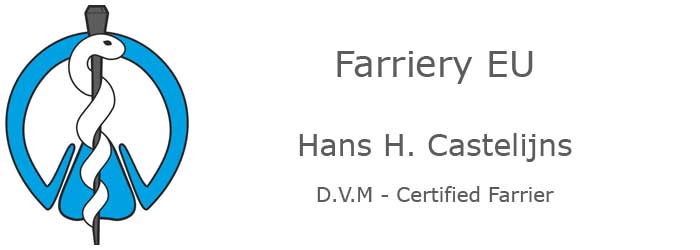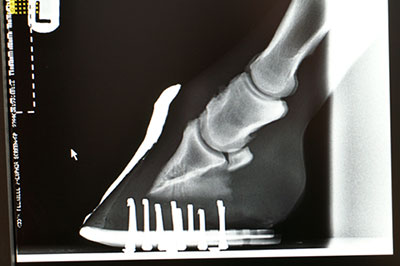New strategies for treating club foot from foal to adult.
|
Club foot is best described as hypo-extension of the distal inter phalangeal joint (DIPJ), usually on the front limbs.
Foals can be born with the condition.
They can acquire the condition during rapid growth (2-4 months of age), when the lengthening of the distal limb, with active growth plates at the second and first phalanx (PI, PII) and metacarpus III (MCIII), can cause the distance -between the proximal attachment of the inferior check ligament (ICL) and the distal attachment of the deep digital flexor tendon (DDFT) at the cresta semilunaris of the third phalanx (PIII)- to increase to rapidly for the DDFT and its check ligament to follow suit.
This acquired condition can have a sudden, bilateral, onset, where by the heels of the front feet don’t touch the ground (“ballerina syndrome”) and the foals stand on their toes.
Grass-foot is the condition where the foal adopts a grazing / feeding stance with one foot forward and one foot back ward -under the body- to easier reach the ground while feeding. In this case the later distal limb will have a more upright conformation.
Finally, yearlings can break off large portions of their dorsal hoof wall when the ground hardens up after a wet spring and, besides being foot sore, become quite upright in a short time.
Treatment depends on the foals age and cause of the condition, and includes:
- Medical: oxytetracycline 1-3 grams e.v. in newborns, tetracycline’s are supposed to chelate hematic calcium, there by relaxing the muscle – tendon unit. This treatment should be reserved for newborns and it should be realized that it relaxes (extends) all joints.
- Management: As fast growth is responsible for the “ballerina syndrome”, and fast lengthening of the distal limb and pain (the miotactical reflex) exasperates the condition, stall rest and dietary (energy – carbohydrate) intake restriction is called for. At two to 4-5 months of age, the distal growth plates are often inflamed (epiphysitis). Bandaging with Robert-Jones type bandaging also releases the flexor muscles. The mono lateral condition is exasperated by flat, lush pastures with short grass, therefore pasture restriction, change to hillier pastures, and feeding in raised mangers are beneficial.
- Surgery: elective surgery consists of desmotomy of the inferior check ligament. Al though this can contribute to good functional results, ugly scars and thickening of the palmar, proximal aspect of MCIII is often the result.
- Therapeutic shoeing: Depending on the age, degree of hypo extension of the DIPJ and bilateral / mono lateral condition, appropriate shoeing may include:
- Toe extensions with polymers, with foal shoes, with nailed or glued on aluminum shoes or a combination of these. An important, and paradoxical part of the shoeing consists in raising the heel(s) in combination with the toe extension. The raised heel(s) relax the tension of the DDFT and the ICL and reduce the tension – pain – further tension loop. The raised heels are slowly lowered over time.
|
The author has used this gradual approach over the years, with often astonishing results even in older (6-7 months) foals without the need for surgery.
To make things easier on the farrier, patient, and stud manager, the author’s preferred method is the application of a glue on shoe (Dallmer® *1 foal shoe or cuff) after trimming the heels to normal desired length. An aluminum plate with a toe extension of the same length as the hoof, a rockered toe and initial heel elevation is then screwed on to the shoe. The heel elevation should be high enough to make the DDFT feel less tight on palpation. Every few days the plate can easily be removed with an electric screw driver, the heel elevation reduced, and the plate reapplied at a lower height as the condition improves.
It is important to note that management measures, stall rest on firm footing followed by controlled exercise and dietary restriction, have to be taken as well.
On yearlings the application of a sole-covering aluminum shoe, usually of 6 mm thickness with a slight toe extension, with premium rehe ® *2 applied between the sole and the shoe, while leaving the frog uncovered, has given good results when the toe is excessively worn / broken off. At this age these shoes can usually be nailed on with small nails.
It has been the author’s experience that with this modern version of an age-old treatment (the” Florentine” shoe) inferior check ligament desmotomy can often be avoided. It should be noted that in the case of surgery a toe extension, in this case without initial heel elevation, is still called for during recovery / rehabilitation.
|
|
|
|
|
Figs1-5 show toe extension + heel raise on a glue-on cuff (Dallmer B)
|
|
- Adults:
In adult horses the inability to extend the DIP joint normally (club foot) is usually the result of the condition not being corrected at the foal stage, it can however also be a condition acquired later in live. In the first case it is usually the inferior check ligament which is relatively short, in the second case it is mostly due to the shortening of the deep flexor muscles as a result of chronic pain as in laminitis (the so-called phalangeal rotation).
A simple clinical test consists of attempting to extend the DIP joint manually while holding the cannon bone horizontal; if the joint extends in this position, its hypo-extension is due to muscle shortening, if it doesn’t extend it is due to a short check ligament. Surgical treatment therefore would be deep digital flexor tenotomy in the first case and inferior check ligament desmotomy in the second. Shoeing adult horses with this conformation should aim for comfort and prevention of ring bone. The reduced capability of dorsal extension of the Dip joint- which can be precisely measured with the help of a digital extension device- should be addressed by applying a sharp rocker to the toe of the shoe. This rocker should be placed around the distal tip of PIII, preserving sole depth under the tip, which tends to lower itself in to the sole body.
It is important to dress back any dorsal hoof flares as they increase laminar tension in the toe. Finally, as these horses have tall, long, strong and fast-growing heels it can be useful to give the shoe rockered (bent up) heels; at speed this limits the angular velocity (degrees per second) with which the Dip joint changes angle on landing heels-first. The author believes that the fast, repetitive change of angle of the joint on landing at speed is responsible for the high incidence of entheseophyte formation at the distal insertion of the extensor tendon aponeurosis (ring bone).
|
| |
*1 )Dallmer foal shoes Andreas Strohm, www.strohm.de
*2) Premium-rehe – Luwex Gmbh – Regenburger StraBe 67 D-92224 Amberg. |
|




